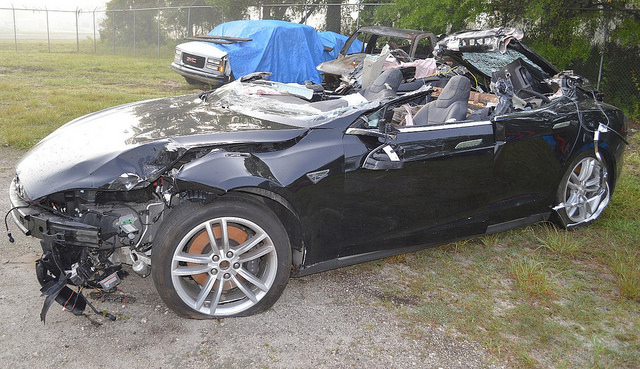Is a Tesla on Autopilot safer? Maybe, but Elon Musk’s stats are crooked

Elon Musk says Tesla is twice as safe with Autopilot on, but his stats don’t add up.
Here’s Musk’s tweet.
Here’s the quote from Tesla’s report, as published in Teslarati:
“In the 4th quarter, we registered one accident for every 2.91 million miles driven in which drivers had Autopilot engaged. For those driving without Autopilot, we registered one accident for every 1.58 million miles driven. By comparison, NHTSA’s most recent data shows that in the United States there is an automobile crash every 436,000 miles.”
Doing the math, Teslas on autopilot are only 54% as likely to have a crash as when people are driving them in the usual way. And even in normal mode, a regular car is 3.6 times as likely to have a crash as a Tesla.
Have you spotted the problem yet?
Don’t compare statistics with different bases
I just tried out the Autopilot on my Tesla yesterday. It works fine — on the highway. As soon as you’re off the highway, the car returns control to you.
So the Tesla Autopilot crash stats are for highway driving, while the other stats are for all driving.
But according to the US Federal Highway Administration, Americans drove 3.2 trillion miles in 2017, of which 2.3 trillion were on Interstate highways and other arterial roads, and 0.9 trillion were on other types of roads. Assuming Tesla drivers drive in about the same proportions as other drivers, about one-quarter of the driving is not on highways.
So the bases are very different.
Do more crashes happen on highways or in other locations? The five most common locations are intersections, traffic lights, busy two-lane roads, parking lots, and rural highways. Only one of those reflects highway driving.
Think about your own experience. If you got into an accident, where was it?
Probably in a parking lot, at an intersection or light, or on a narrow, crowded road.
A Tesla on Autopilot is not driving in any of these places.
So the fact that Teslas on Autopilot are half as likely to have an accident could easily just be due to the fact that those Teslas are driving on the highway where there are fewer crashes.
How much of the improvement is due to this? Until Tesla releases statistics on highway crashes on and off Autopilot, there’s no way to know.
Could a Tesla save your life?
The faster you are going, the more likely that a crash will kill you.
While I could not find statistics on fatal crashes on highways compared to fatal crashes on other roads, it’s quite likely that, given the speed involved, highway crashes account for a disproportionate number of fatalities.
For example, NHTSA statistics show that half of the fatalities involving speeding were on highways. About 13% of all the fatalities were from crashes involving large trucks, which are more likely to be on highways.
Furthermore, according to the National Highway Traffic Safety Administration, “Dangerous actions such as speeding, distracted driving, and driving under the influence are still putting many Americans, their families and those they share the road with at risk,”
Tesla and Autopilot will increase your likelihood of avoiding such crashes.
NHTSA gave the Tesla Model 3 the highest safety rating possible. The car warns you when you are heading for a crash (I’ve experience this myself — it’s very helpful.) And if you make the very stupid decision to drive while impaired, the Autopilot could save you.
These stats are all worth bragging about. It’s a very safe car.
But it’s not twice as safe on Autopilot. Tesla and Musk ought to stick to the statistics that they can defend, not those for which different bases render comparisons useless.
It is hard to find data, but crash rates certainly vary by road type. One study of two states showed (2 states, urban and rural freeway rates) of 0.78, 0.79, 0.52, and 0.81 crashes per million miles of VMT, while urban and rural two-lane highways for the two states had rates of 1.07, 1.86, 2.50, and 2,50, with urban two-lane highways having the highest rates. (see https://www.fhwa.dot.gov/publications/publicroads/94summer/p94su44.cfm). Rural areas have a much higher fatality rate, though (“The fatality rate per 100 million vehicle miles traveled was more than double in rural areas than it was in urban areas (2.25 and 0.89 respectively, https://safety.fhwa.dot.gov/local_rural/rural_fatal.cfm).
Also, this analysis (https://www.greencarreports.com/news/1119936_tesla-fatal-crash-rate-with-autopilot-still-no-better-than-with-human-drivers), if correct, concludes that Tesla’s autopilot has a higher fatality rate than human drivers, albeit 1) the data is sparse and estimated and 2) it doesn’t consider the point you’ve made. Urban and slower speed roads have lower fatality rates, and those are the ones driven by humans.
When I think about self-driving vehicles I am excited about the potential to do better with time, pollution, and safety. Then I think about trains and realize that they have an advantage only in the pollution aspect.
Trains are on dedicated lines with little horizontal movement. And yet they do poorly with timing and safety.
Trains would be a great place to perfect self-driving. Or pick a closed community.
The data concerns you point out are typical…we drown in data and usually have none of the relevant data.